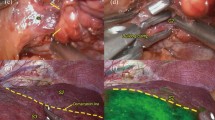Abstract
Background
Many studies confirm that anatomical resection was associated with favorable oncologic outcomes for patients with HCC who had preserved as much of the remnant liver tissue as possible.1,2 In recent years, laparoscopic liver resection has been widely extended from minor resection to complex hepatectomy,3 However, surgery on tumors located in the posterosuperior segment remains a demanding procedure regardless of the extent of resection.4 Laparoscopic anatomical segment VII resection has one of the highest difficulty scores based on the tumor location due to poor accessibility, hard to exposure, and difficulty in obtaining sufficient surgical margins.5,6 Here, we report a totally laparoscopic anatomical VII resection using the Glissonian approach with indocyanine green dye fluorescence.
Methods
A 74-year-old man with a body mass index of 31.9 kg/m2 suffered from HBV-related cirrhosis was admitted to our institution. The preoperative Gd-EOB-DTPA MRI showed a 2.7-cm HCC located in segment VIII. The preoperative AFP is 3431 ng/ml. A true anatomical segmentectomy was performed by using selective occlusion of segment VII Glissonian pedicle, which was identified from the liver hilum. Indocyanine green (ICG) dye demarcation was used as a guidance during parenchymal transection.
Results
The operative time was 270 min with an estimated blood loss of 200 mL. The postoperative course was uneventful. Drainage tube was pulled out on the fourth day. The pathology confirmed the diagnosis of hepatocellular carcinoma and the surgical margin was negative. The patient was discharged on the 8th day after operation.
Conclusions
Totally laparoscopic anatomical segment VII resection is a technically challenging operation. Advanced laparoscopic skills are necessary to complete such a difficult procedure safely. Glissonian approach and ICG fluorescence imaging guide parenchyma resection could be help.
Similar content being viewed by others
References
Hasegawa K, Kokudo N, Imamura H, Matsuyama Y, Aoki T, Minagawa M, Sano K, Sugawara Y, Takayama T, Makuuchi M. Prognostic impact of anatomic resection for hepatocellular carcinoma. Ann Surg. 2005 ;242(2):252–9
Kaibori M, Kon M, Kitawaki T, Kawaura T, et al. Comparison of anatomic and non-anatomic hepatic resection for hepatocellular carcinoma. J Hepatobiliary Pancreat Sci. 2017 ;24(11):616–626
Wakabayashi G, Cherqui D, Geller DA, et al. Practical guidelines for performing laparoscopic liver resection based on the second international laparoscopic liver consensus conference. Surg Oncol.2018;27(1):A5–A9
Ishizawa T, Gumbs AA, Kokudo N, Gayet B. Laparoscopic segmentectomy of the liver: from segment I to VIII. Ann Surg 2012;256(6):959–964
Ban D, Tanabe M, Ito H, Otsuka Y, Nitta H, Abe Y, Hasegawa Y, Katagiri T, Takagi C, Itano O, Kaneko H, Wakabayashi G .A novel difficulty scoring system for laparoscopic liver resection. J Hepatobiliary Pancreat Sci .2014;21(10):745–753
Kazaryan AM, Rosok BI, Marangos IP, Rosseland AR, Edwin B. Comparative evaluation of laparoscopic liver resection for posterosuperior and anterolateral segments. Surg Endosc.2011;25 12.:3881–3889
Funding
This study was supported by a grant from the Guangdong Provincial Health and Family Planning Commission (No. A2016069).
Author information
Authors and Affiliations
Corresponding author
Ethics declarations
Conflict of Interest
The authors declare that they have no conflict of interest.
Additional information
Publisher’s Note
Springer Nature remains neutral with regard to jurisdictional claims in published maps and institutional affiliations.
Electronic supplementary material
ESM 1
(MP4 475 mb)
Rights and permissions
About this article
Cite this article
He, Jm., Zhen, Zp., Ye, Q. et al. Laparoscopic Anatomical Segment VII Resection for Hepatocellular Carcinoma Using the Glissonian Approach with Indocyanine Green Dye Fluorescence. J Gastrointest Surg 24, 1228–1229 (2020). https://doi.org/10.1007/s11605-019-04468-7
Received:
Accepted:
Published:
Issue Date:
DOI: https://doi.org/10.1007/s11605-019-04468-7



